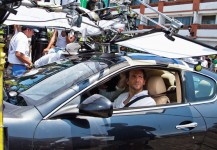By Daniel Miller, The Hollywood Reporter
March 11, 2011, 3:10 p.m.
“They jumped right in and did it, and they creatively fit the bill,” says Scott Kroopf, producer of Limitless, which comes out March 18 and centers on a man whose life is changed when he takes a pill that allows him to tap his mind’s full potential. “We were looking for a company that could deal with the short time frame and not do the usual process, which always takes several months.”
To pull it off, Maserati sourced a dark-gray GranTurismo Coupe from its official importer in Mexico and shipped a matching four-seater from the U.S. to Puerto Vallarta in time for filming in June. No money changed hands in the deal; in the end, Maserati spent less than $10,000 on the project — with most of that going toward shipping costs and payment for a company technician who was on location for the one-day shoot.
Onscreen, the result is less than one minute of fast-paced footage of Cooper and the car making their way through the city. However, the impact of the deal could run deep. For Maserati, a boutique nameplate owned by Italy’s Fiat Group that returned to the U.S. in 2002 after an 11-year absence, it is another chance for what is practically free publicity. Two Limitless advertisements prominently featuring the car ran during February’s Super Bowl, an early payoff that even Maserati didn’t expect, says Jeffrey Ehoodin, public relations manager at Englewood Cliffs, N.J.-based Maserati North America.
“The brand familiarity is extraordinary, but the product familiarity, because of our small size and tight advertising budget, is a challenge,” says Ehoodin, who spearheads the company’s product-placement efforts. “With a commercial like that, we are beginning to see product recognition for our GranTurismos.”
“We were looking for a company that could deal with the short time frame and not do the usual process.” — “Limitless” producer Scott Kroopf
Maserati doesn’t make a practice of paying for placement in films and TV, but some of its competitors do — though placement experts are loath to reveal those who dole out the dollars. Generally, paying for a placement isn’t as simple as writing a check. Often, carmakers will commit to spending advertising dollars to help promote a film and a car’s inclusion in it — spending up to $10 million for a campaign, says [highlight]Cat Stone, partner at Stone Management[/highlight], an L.A.-based product-placement, branding and promotional consultancy.
“Many of the large studios won’t consider a promotion for under a million dollars,” says [highlight]Stone[/highlight], who was hired by Relativity to handle its automotive-placement needs for Limitless and ultimately connected the filmmakers with Maserati. “The idea in this film was, when you have something scripted that perfectly fits, you have the capability to do a placement without any money changing hands.”
Maserati stopped hiring product-placement consultants in 2008, the year the recession crippled the high-end automotive marketplace, forcing many companies to winnow their marketing budgets. (Indeed, many wealthy people mothballed their sports cars out of embarrassment during the dark days of 2008 and 2009.) But the company’s scaled-back efforts haven’t stopped it from snagging recent placements in television shows such as Showtime’s Californication and the feature film Love, Wedding, Marriage, due out this year.
“They are networking to create those relationships,” says Stacy Jones of Hollywood Branded, a marketing firm that represents companies including boutique carmaker Morgan. “Are they in as many productions as they could be? No. Are they in as many as they want to be? Possibly.”
Ehoodin says he’s pleased with Maserati’s “guerrilla-style effort,” and it is fitting for a company that has never sold more than the 2,541 cars it moved in 2007, when the GranTurismo Coupe launched. The convertible version, which starts at $140,200, came out last year. Although Car and Driver, Motor Trend and other trades have given the convertible strong write-ups, noted automotive writer Dan Neil of the Wall Street Journal and a handful of others have given GT models less-than-stellar reviews during the past few years, knocking their at-the-limit handling and performance. It’s possible an association with heroes of both the small and silver screens could be a difference-maker for Maserati.
If there is one murky facet of automotive product placement, it’s quantifying how such opportunities impact sales. Rebecca Lindland, an automotive analyst at IHS Global Insight, says placement of luxury cars doesn’t necessarily translate into sales, though it does translate into aspiration. But Ehoodin says that in at least one instance, placement directly resulted in sales: The company’s Quattroporte sedan was featured heavily in the second season of HBO’s Entourage and was in fact a plot point. In Episode 2 of that season, which aired in 2005, burgeoning Hollywood star Vincent Chase buys a silver-on-black version of the sedan for his manager and best friend, Eric “E” Murphy. From then on, the car was included in several episodes of the show and Maserati never paid for the placement. It couldn’t have come at a better time for the company, which was only three years into its U.S. relaunch.
“We literally had people coming in over and over again to our dealers, and they were mentioning the show,” Ehoodin says. “The setup — silver with a black interior — became known as ‘E’s car.’ It did wonders.”

